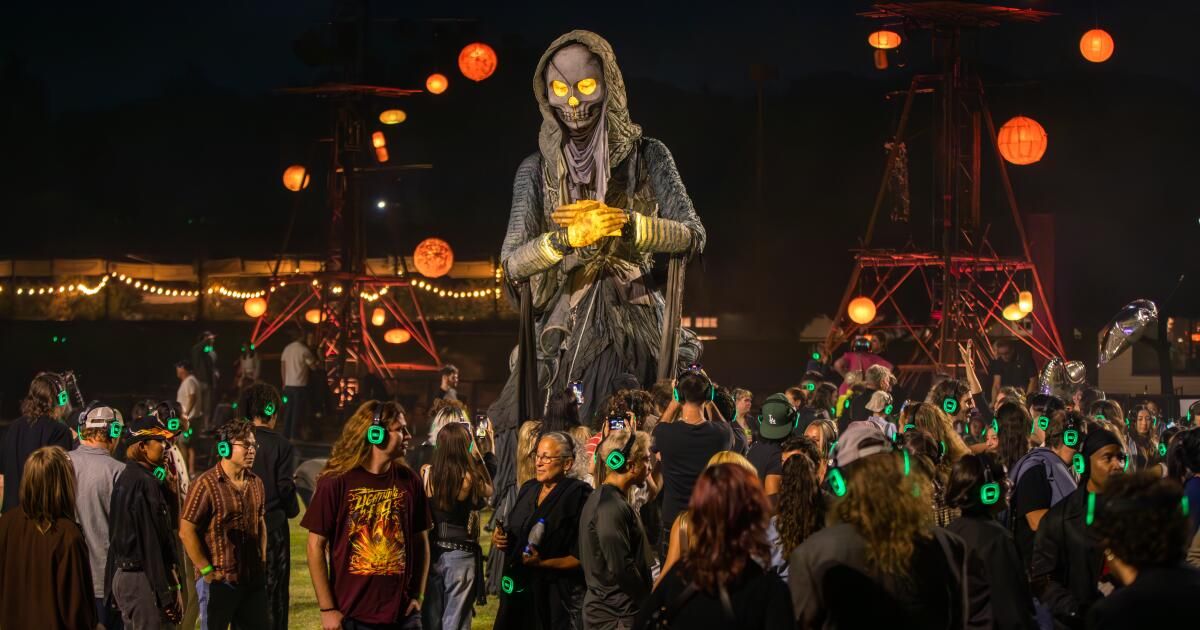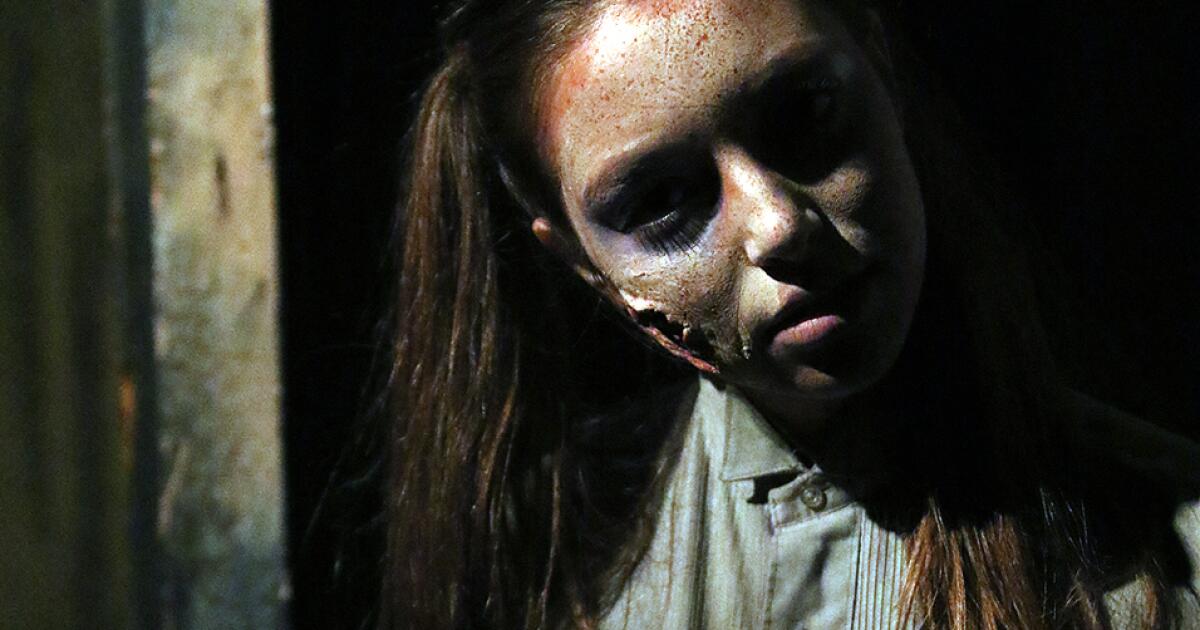Tell someone about “The Cortège”, and can inspire so much apprehension as curiosity.
A theatrical procession that extends this month at the Equestrian Center in Los Angeles, “The Cortège” promises to explore pain, loss, duel and our collective disconnection with each other. It is a dramatic interpretation of a funeral, although with a joyful dance inspired by the street and a creature similar to Sasquatch. And robots and drones.
I arrived at “The Cortège”, only weeks eliminated from attending a very real and deeply personal funeral for my mother. Did I want to visit that space again as part of my weekend entertainment, and the program would inspire a new round of tears? The answer to both turned out to be yes.
“The Cortège” is alternately playful and serious, since the cycle of life explores.
(Emil Ravelo / for the times)
Because “The Cortège” addresses a difficult topic with an imaginative question: what happens if we explore pain not with isolation or solemness, but with astonishment? It is a warning that is mature for a divisive era, financial stress already often isolating technology.
Starting in the twilight and extending until night, “The Cortège” begins with an overture, a six -piece band that is presented in the center of the field. We are sitting on the grass on portable pads with backs or in folding chairs on a high platform.
Soon, a fog explodes at one end further from the field; A lonely figure arises that crawls and then walks towards the center. It will move instead for much of the show, remain silent when a fantastic life occurs around it: dancers, ornate characters and bigger puppets that life will surreally reflect the journey of life.
-
Share by
Inspired both by the Walt Disney approach to fairy tales and, for example, the theories of the collective consciousness of Carl Jung, “The Cortège” is a rebirth of an ancient art, the procession, which aims to be a modern passage rite. A ritual, “The Cortège” is a community experience, one that seeks to erase the borders between the audience and the interpreter while imagining a more optimistic world.
Think about it as a theater as a healing exercise, or simply as an abstract night with vibrant and vibrant costumes and drones that create new constellations in the sky. It is also a dance party, with original music composed of Tokimonsta, the owl and bort.

“The Cortège” accumulates in a final that invites the participation of the audience, and perhaps a little dance.
(Emil Ravelo / for the times)
“The Cortège” comes from Jeff Hull, an artist from the Bay area better known for designing participatory and mysterious experiences that have used real world environments as a game board; Some may remember the beloved underground experiment “The Jejune Institute”. This, however, is a more personal show. It is informed both for the struggles and challenges of adulthood, since it is the astonishment and game that Hull experienced when he was younger, specifically his time working in Oakland's Children's Fairyland, a playground of the theme park for young children.
“Every day I followed the yellow brick path and had a magical key and slid through a rabbit burrow, and wondered why the rest of the world was not so,” says Hull. “I have been trying to do so since then. Why can't we play? Why does everything have to be barriers? That is the motivation of a children's place, but now I also have motivation of a wise elder space.”
In turn, “The Cortège” is part of the festive renewal and part of the philosophical memory. At the beginning, music is sad but not very sad, a slightly contemplated feeling inspired by jazz anchored by a steel drum. Music changes through reggae styles and oriental rhythms. The artists are tunic and the instruments are taken to the darking trucks, establishing the transitory mood of the night.
What follows will be the religious and mystical iconography: we will meet three masked figures that carry flashlights, for example, with exaggerated and royal ornaments while announcing a birth. Wait a mixture of old and new technologies. The drones will be formed to mark a passage from times, a music band will conjure the New Orleans spree, and hairy and heavy creatures can invite the youth spirit, while militant and robotic canines will represent images of ingenuity and human violence.

Think of “The Cortège” as a rite of ceremonial passage, a program that wants the public to find healing through the community.
(Emil Ravelo / for the times)
During much of the show, we are asked to use bright headphones. Its luminescence stands out to the crowd while creating a more intimate and reflective atmosphere. It is not a sound bath and it is not a play, but as more figures enter the field, some disturbing and dreaming of their bodies formed as arrow points, and others more burst of feathered color, “The Cortège” acquires a ceremonial and meditative sensation.
While some may come through the huge costumes and extended dance sequences, Hull says that the show is the entertainment equivalent of “shadow work”, which is the therapeutic discovery of suppressed, forgotten or hidden memories.
“Shadow work is something we must do as individuals, but it is also something we must do as a culture,” says Hull. “Let's look at ourselves. Let's see what we don't want to admit about ourselves. How can we give it life? When you do it as an individual, we are actually doing something for the collective. That is a great aspect of 'The Cortège'. Let's do work in the shadow as a cultural moment.

The public is asked to use headphones during “The Cortège”, creating an intimate relationship with music.
(Emil Ravelo / for the times)
However, ultimately, “The Cortège” is an invitation, an extended hand to the audience that asks us to consider and reintime our own journey through life. Setting both the traumatic end of a relationship and my mother's death, I appreciated the way in which “the curtain” sought to put our existence in perspective, to reinterpret, essentially, the individual as the communal of a reminder of celebration that we have all fought as much as we have dreamed.
Hull says that “La Curtina” was born from a time of conflict.
“What you mentioned, losing a loved one and going through a separation, my version of that is that I had the Guillain-Barre syndrome and was walking with a cane. My wife was diagnosed with cancer and then lost her father. And this was for a time when the sun did not come out. It was dark, all day, due to the wild fires of California. He mentioned everything that mentioned everything that mentioned everything that mentioned everything that mentioned everything that I realized that all those who mentioned everything that mentioned everything that mentioned everything that mentioned everything that all those who mentioned all those who mentioned everything that mentioned everything we mentioned.
The program is abstracted on purpose, says Hull, to allow members of the audience to attach their own stories. It is a job of Boato, inspired by Hull's fascination with the works of medieval morality, specifically the story of “Everyman”, an examination of himself and our relationship with a superior power.
“The story of 'Everyman' was one in which a universal protagonist met all the challenges of life and a calculation with himself and with God,” says Hull. “That is literally what we are doing here. It is a rebirth of the old European Boato.”

The drones will form constellations in the sky during “El Cortège”.
(Emil Ravelo / for the times)
Hull's name is well known among those who follow what the niche still emerges from the so -called immersive entertainment, media that, in general terms, asks the participants to assume an interactive role. Those who deepened in the “Jejune Institute”, which extended at the end of the 2000s in San Francisco and inspired a documentary, as well as the AMC series “Dispatches from Otherwhere”, could discover a narrative that examined fragility, or the charm of human belief systems. It was often, for example, compared to a cult.
“The Cortège” is clearly a game. And the helmet today is skeptical of the word “immersive.” Although “The Cortés” invites the public to the field in its final act and then asks the participants to join a reception (future life), Hull finds much of what is classified today as immersive, emphasizing shows and images about human emotion.
“The Cortège,” says Hull, “is not a metafiction.” Or do not think about it as a show about a rite of initiation. It is intended to be a rite of themselves. “That is the thesis of this piece,” says Hull, 56, before expanding his evolved version of the immersive field.
“This world of immersive entertainment is, but what are we immersing ourselves?” He says. “Is this only sensory stimulation? Is this a gesture in the numinous? This reference to mystique? There is no meta-narrative here.”
Hull's hope is that “The Cortège” will erase the line between the performative and the restorative. “We all want to have a simulated meta -critical relationship with transformative experiences instead of genuine transformative experiences,” he says.

It is not a play and it is not a dance show, “The Cortège” incorporates elements of both during their procession.
(Emil Ravelo / for the times)
We can get there, he believes Hull, committing himself to an art form that has been largely ruled out by the western world.
“We are reconnecting a lost lineage to the old and what is eternal,” says Hull. “A procession is people walking together; that is simply a procession. Where are they walking? They are walking from their past. Where do they walk? They are walking to the future. That is what we are doing.”
I am not going to spoil the moment that made me cry apart from saying that it was not due to the shaking of any memory. Because “The Cortège” is also exultant: a procession, yes, but a walk through an imagined world.













